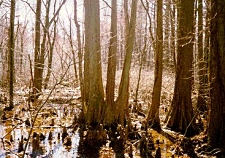Wildlife - Species

Bald Cypress (Taxodium distichum)
Description
Bald cypress belongs to the cypress family (Taxodiaceae). It is a large deciduous tree that can reach heights over 40 m (130 ft) tall with a diameter of 4 m (13 ft). The bark is thin (about 1 cm or 0.5 in thick), gray-brown, and rough in texture. The light green leaves are 1-1.5 cm (0.5-0.75 in) long and needle-like or flat linear in shape. The flowers are monoecious (individual flowers have either male or female flower parts). Male flowers (contain stigma, the pollen- producers) are minute, purple in color, and grow in drooping panicles that originate at the end of the previous year’s twigs. The female flowers are inconspicuous and composed of several spirally arranged, overlapping scales that bear two ovules (seed producers). The cones are made of a few four-sided scales, and each scale bears two triangular seeds. Each cone contains 18 to 30 seeds that have a thick horny coat and irregular projecting flanges or wings along the sides. The most distinctive features of the trees are the swollen, fluted trunks at the base of the tree and the above-ground root structures, commonly known as "knees."
Preferred Habitat and Biology
The natural range of bald cypress extends from Delaware to Florida and west through Texas, almost to the Mexican border. It is also found in Missouri, Illinois, Indiana and Oklahoma, but a few trees have been planted as far north as Massachusetts and Michigan. In the ACE Basin, the largest stands of bald cypress are found along the South Edisto and Combahee Rivers, above the intersection of U.S. Highway 17. Although bald cypress trees will grow under a considerable range of climatic conditions, they reach maximum heights in warmer climates. The trees typically inhabit the organic and clay soils in the deepest areas of swamps along water bodies and in flood plain forests. However, bald cypress trees planted in moderately well-drained fine sandy loams grow well.
Contrary to the popular belief that bald cypress are slow-growing trees, the growth rate of trees less than 100 years old is comparable to that of other trees growing in the swamp. Populations of bald cypress are maintained by sexual reproduction. Seeds are produced each year, and a good seed production occurs at intervals of about every 3 years. Seeds mature by fall, and they fall to the ground from late October to November. Although bald cypress trees grow well on moderately well-drained fine sandy loams, the trees are restricted to wetlands because of the water requirement for seed dispersal, germination and seedling growth. Water is necessary for seed dispersal because only a few seeds are disseminated by animals, and the wind cannot lift the large, small-winged seeds. The majority of the seeds will only germinate after 1-3 months of submergence after water has caused the hard seed coats to swell and soften. The best seed germination also occurs on wet, organic, or peaty soils. Seedlings sprout when the water recedes, and the ground remains saturated during the growing season. However, the water must remain below the leaves of the growing seedling except for short periods (5 weeks or less). Seedlings usually grow 40 to 51 cm (16 to 20 in) during the first two years. The species flowers during the winter, and pollination occurs before the leaves emerge in spring. The cones mature by late October and November, becoming brown and woody. The seeds then break away from the scales and fall to the ground. Occasionally the entire cone falls to the ground before the seeds are released.
Species Significance
Bald cypress wood is highly valued for its resistance to decay. The sticky, red resin on the seeds appears to repel many animals, and rarely are the seeds eaten by birds and mammals. The Florida crane, gadwall and mallards are a few of the animals that eat the seeds of bald cypress.
References
Langdon, O.G. 1958. Silvical characteristics of bald cypress. Southeastern Forest Experiment Station. Asheville, NC. U.S. Department of Agriculture, Forest Service.
Martin, A.C., H.S. Zim, and A.L. Nelson. 1951. American wildlife and plants: A guide to wildlife food habits. Dover Publications Inc., New York, NY.
Radford, A.E., H.E. Ahles, and C.R. Bell. 1968. Manual of the vascular flora of the Carolinas. The University of North Carolina Press, Chapel Hill, NC.
